20 years on, Kit Chapman investigates how a scientific scandal unfolded
On the morning of Monday 19 April 1999, Darleane Hoffman received a phone call. Hoffman was the head of the heavy element team at Lawrence Berkeley National Laboratory, US. Three researchers from the team’s particle accelerator wanted to meet with her immediately.
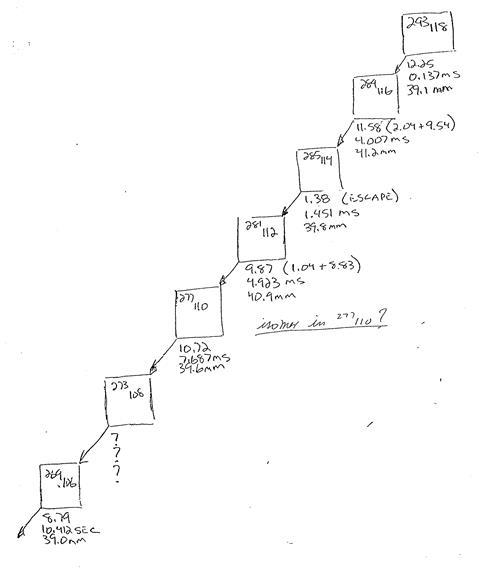
Hoffman assumed something was wrong. For almost two weeks the team had been trying an unorthodox nuclear reaction in their 88-inch (2.24m) cyclotron, an attempt to discover element 118. The project was a trial run for testing the cyclotron’s new gas-filled separator – an instrument to strip out the background noise when trying to detect newly created elements. As usual when it came to fitting and calibrating new pieces of kit, the team had been plagued with endless technical problems as they worked out the teething troubles.
Don’t worry, Ken Gregorich, team leader and the voice on the other end of the phone, reassured her. This was very good news.
A few minutes later Gregorich arrived in Hoffman’s office. With him were Walter Loveland, a researcher taking a sabbatical from Oregon State University, and Victor Ninov, the rising star of heavy element research. Ninov handed over a hand-drawn chart to Hoffman. On 13 April the machine had detected a series of energy signatures caused by alpha particles. These could have been jettisoned from a newly fused nucleus – the tell-tale signs that a new element had been created and was decaying through alpha emission – or equally could have just been experimental artefacts, phantoms in the machine. Away from the rest of the team, Ninov had been scouring the computer’s data for stronger evidence of what was going on.
On 15 April, he had found it. The sheet he gave Hoffman showed Berkeley’s experiment had discovered not one but three new elements.
There was just one problem. It wasn’t true.
The superheavy race
19 April was an auspicious date for element discovery. It would have been the 87th birthday of Glenn Seaborg, the former leader of the Berkeley team who had died two months earlier. Since taking over the Berkeley team in 1940, Seaborg and his long-time collaborator Al Ghiorso had turned Berkeley into the most successful element makers of all time. Seaborg’s discovery of plutonium had won him the Nobel prize, while his actinide series had reshaped the periodic table. By the 1970s, the team had moved beyond even these, reaching the realm of the superheavy elements.

Superheavy elements don’t occur naturally on Earth. Instead, they are made one atom at a time in particle accelerators, firing beams of ions into target atoms in the hope that the nuclei fuse together to create a new, larger element. In theory, this just needs an ion beam fired at target with the right number of protons. For example, the Berkeley team, led by Ghiorso and working with nearby Lawrence Livermore National Laboratory, had made element 106 in 1974 by shooting oxygen ions (Z = 8) into californium (Z = 98). In practice, the technique is far more difficult. Hits are rare, and far more likely to result in the nucleus breaking apart – atomic fission – than a new element. And even if a new element is produced, it is usually so unstable it radioactively decays in seconds.
Unfortunately, this lack of concrete evidence, which occurred at the height of the cold war, meant element discoveries were hotly contested by a rival group in Dubna, USSR, led by Georgy Flerov and Yuri Oganessian. It wasn’t until 1993 that Berkeley had been confirmed as element 106’s discoverers – and it took a further four years for everyone to agree it should be called seaborgium.
Seaborgium had proved the end of Berkeley’s element discovery streak. In the interim, the team’s rivals had pushed forward. Throughout the 1980s and 1990s, the German team at GSI Darmstadt had discovered elements 107–112. Eager to get back in the element race, Berkeley had recruited Ninov – a co-discoverer of elements 110, 111 and 112 – from GSI in 1996. Almost immediately, he left an impression on Ghiorso, who told his colleagues that Ninov ‘is as good as a young Al Ghiorso!’ While Gregorich worked on the cyclotron’s separator, Ninov brought with him a computer program, Goosy, that promised to give the Americans a digital edge when it came to data analysis.
It was a move the Berkeley team hoped would get them back in the race for new elements. The Dubna group had partnered with Livermore in 1989 and the joint US–Russian team was already pioneering a new technique it believed could produce up to element 118. In 1998, Oganessian’s collaboration reported they had made element 114 by shooting neutron-rich calcium into plutonium. The claim was still unconfirmed, but Berkeley needed to act quickly if it wanted to keep pace.
At first, the Berkeley team had considered repeating the Russian method. However, they didn’t have permission to use radioactive targets with their new gas-filled separator, or a good supply of the rare calcium-48 isotope in its metallic form needed to create the ion beam. Instead, they decided to turn to the ideas of a theoretical physicist from Poland, Robert Smolańczuk, who predicted element 118 could be created easily by bombarding lead-203 with krypton-86. It was an idea that flew against all conventional wisdom, with most models suggesting such a reaction would take decades to produce a single atom, but Hoffman and Ghiorso – still coming into the lab in his mid-80s – had decided to go for it. Smolańczuk had come over to California on a Fulbright scholarship to work with the experimentalists operating the cyclotron in 1998. In less than six months, the Berkeley team was ready. ‘Robert’s reaction’ was go.
Aren’t we all lucky? We’re grad students and we’ve discovered a new element!
When Hoffman saw Ninov’s analysis, she was astonished. The data showed three decay chains, two of which had radioactive half-lives very close to Smolańczuk’s predictions. The krypton and lead nuclei had fused together to form element 118, before radioactively decaying into elements 116 and 114 in sequence. Berkeley’s gamble seemed to have paid off.
‘Does Robert talk to God or what?’ Ninov asked, grinning.
Yet Hoffman was too experienced to grab the element without checking. In 1952, she had been due to take over a team at Los Alamos, analysing samples from nuclear bomb tests in the Pacific. On arrival, human resources had refused to allow her access to the lab, insisting there had been a mistake – a woman couldn’t possibly be a chemist. While Hoffman was stuck at home waiting for her clearance, her team discovered the first signs of elements 99 and 100. She had been denied discovery of two elements; now, so close, she wanted to be sure. She told the trio to run the experiment again.
On 30 April the team ran the reaction for another six days. This time, only one chain was seen. ‘It was such a startling discovery that strenuous efforts were made to find out if anything had gone wrong,’ Hoffman wrote with Ghiorso in June that year. ‘Nothing obvious was uncovered.’1
On 27 May 1999 the Berkeley team announced the discovery in Physical Review Letters. Anyone involved was included as a co-author, down to the graduate students. One of them, Dawn Shaughnessy, remembers the excitement that rushed through the team. ‘If you worked a shift [at the cyclotron] your name went on the paper. I worked a few shifts, so my name was on it. Aren’t we all lucky? We’re grad students and we’ve discovered a new element!’
‘The news was an enormous surprise to the scientific world,’ Hoffman and Ghiorso wrote. ‘Even if the Dubna/[Livermore] report of element 114 is not substantiated, we have convincing evidence of elements 114, 116 and 118! This opens up a whole new region of study.’1
Around the world, teams began to copy Berkeley’s attempt. It was supposed to be the crowning achievement of Hoffman and Ghiorso’s careers. The world had seaborgium; why not ghiorsium too?
First concerns
Three years earlier, in January 1996, Ninov had made an almost identical trip with his data, this time at GSI with a visit to the German group’s leader, Sigurd Hofmann. Ninov had been a popular member of the team. Born in Bulgaria, his family had moved to West Germany in the 1970s and he had trained as a physicist at the Technical University of Darmstadt. From there he had moved to GSI, and when the lab got new computers in 1988, Ninov established himself as the expert.

The German team had been firing zinc into lead in the hope of making element 112 – a reaction it was sure would work. As the person in charge of the computer, Ninov was in prime position to be the first to see a new element. However, it came as a surprise to Hofmann they were successful so soon. ‘After one week,’ Hofmann recalls, ‘Ninov came to me and said we’d observed something … I asked him to print out the raw data: energy, time, position. It was relatively simple to make such a printout.’ Ninov declined and said he’d do it after lunch. He didn’t, and Hofmann asked him again. ‘He just said “Yeah, yeah, I have no time now”.’ When the printout did emerge, several hours later, the chain was missing all the data Hofmann expected. ‘I told him we couldn’t publish it, we’d have to wait for another event.’ A week later, when the German team did get the data they expected, Hofmann decided only to mention Ninov’s chain briefly in the paper.
When news of Berkeley’s discovery came through in 1999, Hofmann decided to copy the US team’s set-up to confirm the existence of element 118. ‘We immediately got beam time to repeat the experiment,’ he remembers. ‘Krypton is an easy beam, and lead targets are easy too. After one week, we hadn’t seen anything.’ Hofmann recalls arguing with GSI’s director about this apparent failure – but after two weeks he still hadn’t seen a sign of the supposedly easily produced element 118.
The Germans weren’t alone. For the next year, teams in France and Japan tried ‘Robert’s reaction’ and drew blanks. Meanwhile, fellow scientists were becoming confused by Ninov’s behaviour; at conferences, they found him unusually evasive whenever he was asked about his new elements.
Berkeley attempted the experiment again in 2000, but, like the other labs, couldn’t detect element 118. Concerned, it immediately launched an independent investigation chaired by another of Berkeley’s nuclear physicists, I-Yang Lee, to check if something was wrong with its equipment. Lee’s committee checked the experimental conditions, data acquisition and statistics. It also recommended the team ‘complete the independent analysis of both old and new data sets’, although this did not happen. ‘So far, the most likely reason for the difference between the two experiments is the magnet settings,’ Lee reported on 25 January 2001. What other explanation could there be?
Something was terribly wrong
In April 2001, two years after the first test, Berkeley was ready to run the experiment a fourth time. The work had been methodical, aiming to remove all doubt about the discovery. In May 2001 the team tried again. Miraculously, it seemed there was another hit. According to the data, at 12.54pm on 7 May 2001, another decay chain for element 118 appeared.
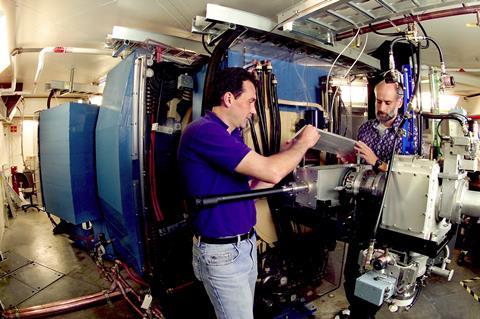
Or had it?
‘In the time that passed,’ Loveland recalls, ‘there were other people who had become expert in Goosy, including my postdoc, Don Peterson.’
‘I was still learning the ropes,’ Peterson, now a researcher at Argonne National Laboratory in Illinois, recalls. ‘Rather than a program per se, Goosy was more akin to an analysis platform for which you could write your own subroutines. I wrote my own independent analysis code for the data, which would serve as a consistency check on any Goosy results.’
Depending on who used the software, you got different answers, and that is just not right
Keen to check everything, Peterson ran the data again from his lab at Oregon State. ‘There was nothing to cause me to check any run for any nefarious purposes. We were simply conducting our own independent analysis – a due diligence effort.’
Goosy’s files gave three pieces of information associated with events related to detecting a new element and its alpha decay chain: the location of the event (in the detector), the time of the event and the energy of the detected particle. But while some of the data was the same, other parts were completely different. ‘Although the implantation event was present, correlations to subsequent decays were absent,’ Peterson explains. ‘I eventually found the other alpha decay events in Victor’s candidate decay chain, but they were not correlated to the original event. They either occurred much later in time or were not in the same spatial location as the original implant.’
Loveland recalls the moment Peterson approached him with his findings. ‘Don looked at this stuff and said “I can’t find the event!” At that point, I thought “Oh God, what’s happening?” Depending on who used the software, if Ninov used it or Don used it, you got different answers, and that is just not right. At that point I started yelling to everyone that something was terribly, terribly wrong.’
Berkeley’s team acted quickly. By 15 June a confidential report by Hoffman to the lab director stated the 2001 chain ‘does not exist in the data’. Team meetings were held daily to check what had gone wrong. At first, everyone assumed there had been a mistake – this was experimental science, after all. Ninov set about checking the 1999 data, others the most recent chain. Phone calls were made, and an independent committee, headed by physicist Gerald Lynch, was drafted in.
The only record available of their discovery is contained on two handwritten pieces of paper
Tension mounted in the group. ‘That summer was a time of general uneasiness,’ Peterson says. ‘At that point of time, everyone was forming their own suspicions and opinions, but they were just that. There was no solid evidence of any wrong-doing – only discrepancies between analysis codes and questions about how one may be interpreting the results of those analyses. While there were whispers and questions, there were very few answers to be found.’
Gradually, the evidence began to fall into place. One of the team’s grad students, Joshua Patin, used Ninov’s Goosy code to analyse the data and came to the same conclusion as Peterson: the events were there but were not correlated with each other. The original 2001 tape logging the raw data had been lost, but copies were found stored on the computer system. The tens of thousands of pages of log data produced by Goosy typically had between 63 and 68 lines per page. The page recording the discovery had 76 lines, suggesting new readings been pasted in with a text editor after Goosy had processed the data. When the supposed discovery was scrutinised further, it was clear it had been fabricated: the log showed the machine had processed a 200MB file in five seconds – much faster than the computer’s capability. ‘This indicates that the program was not really analysing data during this run,’ Lynch would later report.
The 2001 decay chain was fake. What about the chains from 1999? Analysis of the older experiment proved harder, as Ninov had worked alone and recorded his results by hand. The records horrified the independent investigators, who branded them ‘so meagre that they fall outside the normally accepted standards for scientific research’. ‘In fact,’ the committee stated, ‘the only record available of their discovery is contained on two handwritten pieces of paper.’ On 24 July, Gregorich went back and checked the original tapes from 1999. It was the first time anyone other than Ninov had analysed the data. Gregorich’s conclusion was stark: the chains Ninov had reported to Hoffman with such delight were absent. Berkeley’s element 118 had never existed.
The team issued a press release withdrawing its claim and wrote to Physical Review Letters to retract the paper. But the journal refused to accept it; one of the co-authors still stood by his research.
The lone voice of dissent was Ninov.
Mistake or misconduct?
In October 2001 the independent committee published its findings.
In addition to Gregorich’s review, the investigators had also managed to obtain the original 1999 Goosy files from when the computer had saved records automatically if a session crashed. ‘These files show that … events have been modified and added in order to make a complete element 118 decay chain before being reported out by Victor Ninov.’ Goosy was known to be a little quirky – perhaps it had just made a mistake. But the team found ‘no evidence was found that the Goosy analysis framework performed these tasks incorrectly’. That left one possibility.
‘We have found clear evidence,’ the report concluded, ‘that at least one of the 118 element decay chains published in 1999 and the single 2001 candidate decay chain were fabricated.’
The evidence seemed to point at one man. Within a week Victor Ninov was under investigation for scientific misconduct.
Ninov maintained his innocence throughout, replying ‘I stand by the integrity of my research and my interpretations of the data in May 1999.’ While he accepted the data had been modified, he argued that his computer directories were open and his password widely shared around the team: ‘It would have been possible for any of them to intentionally, or negligently, manipulate the data in these files,’ he said. ‘I have never intentionally altered, invented, fabricated, corrupted, deleted or concealed data or experimental observations, or otherwise taken any action that would result in falsifying experimental data or findings of any kind.’
It’s a good thing Seaborg died before this … this would have just about killed him
The misconduct hearing disagreed, stating the evidence was clear. ‘[Ninov] was the only collaboration member doing analysis in 1999, and he was the one who announced both the 1999 chains and the initially claimed decay chain in 2001. If anyone else had done the fabrication, Ninov would almost surely have detected it.’
In 2002 Ninov was found guilty of scientific misconduct by Lawrence Berkeley National Laboratory and dismissed.
For 70 years, Berkeley had been the leading light in element discovery. Now its reputation was in question. Physical Review Letters finally accepted the retraction. Ghiorso’s assessment to the New York Times was blunt. ‘It’s a good thing Seaborg died before this … this would have just about killed him.’
Others in the team felt similarly dejected, but for the lab’s current leader – Darleane Hoffman and the two elements she had missed out on 50 years earlier. ‘When we thought we had [element 118],’ one anonymous member of the Berkeley team says, ‘we had it for her. It was Darleane’s element. And that crushed us more than the retraction – that she didn’t have it.’
The fallout
There was no suggestion that any of the team beyond Ninov were involved in the misconduct. Even so, the Berkeley heavy element team came under criticism for what the misconduct hearing found were ‘disturbing weaknesses’ in its operations, stating they found it ‘incredible that not a single collaborator checked the validity of Ninov’s conclusions’. The lack of documentation was highlighted, as was the ignored recommendation by the Lee committee and the lost data tapes. The committee also pointed out the lack of a defined leader under Hoffman, with the duties divided between Gregorich and Ninov. ‘I had hired a world-recognised expert and we were trusting him to do the job,’ Gregorich told the New York Times. No one had checked the data because no one could imagine what took place.
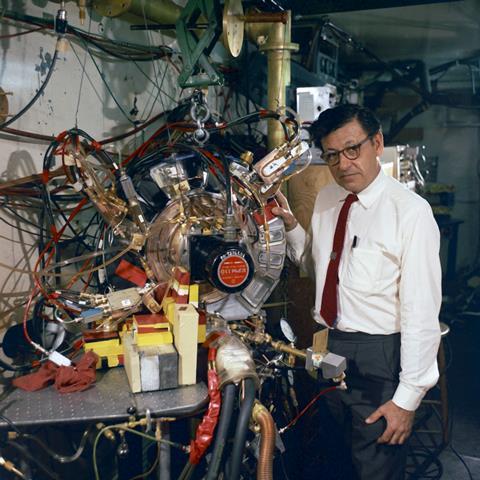
In Darmstadt, Hofmann had worried that Ninov could have pulled the same trick with elements 110–112. Now aware of the reality at Berkeley, Hofmann wanted to make sure his team’s research was beyond reproach. As events in California unfolded, Hofmann approached GSI’s director, Walter Henning. ‘He gave me some good advice: look through all the data Ninov was involved with.’ Hofmann asked one of the staff to go back to the original tapes. ‘He took two or three hours and told me the first decay chain for element 112 did not exist. Then we started looking [at all of them].’
Of the 34 reported decay chains GSI had created, two had been manipulated, including the strange decay chain Ninov had been so hesitant to provide back in 1996. ‘The original tape was not manipulated, but subsequent print outs were. We found them with the help of the computer centre – they make backups so we could find the different versions on Ninov’s computer. He added, step by step, additional numbers to make it look like a decay chain from 112. A second chain from 110 was manipulated too: it didn’t exist.’
The mistake we made was he was the only one that analysed the data
GSI published its findings in detail, referring to ‘inconsistencies’ in the data.3 However, by then the discovery of all three elements had been verified and repeated after Ninov’s departure, and by other teams. The German discoveries stood – which made Ninov’s apparent actions even more puzzling. Why fabricate data when you’ve actually discovered an element? ‘I think he meant it as a joke,’ Hofmann says. ‘And he realised he could manipulate things and nobody realise it. I think that with element 112 he made a serious decision to manipulate the data, which he repeated at Berkeley. The mistake we made was he was the only one that analysed the data. But why wouldn’t you trust him? There was no reason to mistrust him.’
The recriminations of the Ninov scandal – which occurred at virtually the same time as another case of misconduct in the US, involving claims about organic semiconductors by Jan Hendrik Schön working at Bell Labs – were swift and far-reaching. The American Physical Society expanded its ethical guidelines, and dedicated its conference keynote, usually given by a Nobel prize winner, to scientific misconduct.
Most of the Berkeley researchers were worried that, despite being innocent, they would forever be associated with the scandal, says Shaughnessy. ‘The community is so small, that when you went around talking to people … it does travel with you. But the other good thing about the community is that it comes together. Once the community realised he did this in various places, it wasn’t just Berkeley, and we fell for the same ruse that they did, and they did, and they did…’
Shaughnessy joined Lawrence Livermore, whose researchers were still trying to prove their creation of element 114 in collaboration with Dubna. The labs had already put procedures in place to ensure a repeat of the scandal could never occur. While the teams worked together making the element, they worked separately on data analysis, using two entirely different methods to confirm their discoveries. In an act of solidarity, Gregorich and the Berkeley team ran their experiment and confirmed the Russian findings. The community healed.
Lawrence Berkeley National Laboratory’s most recent element success remains seaborgium. Loveland returned to Oregon State University, where he continues his research; Hoffman and Gregorich have retired; Ghiorso died in 2010 but remains the most successful element discoverer of all time. The Dubna–Livermore team, including Shaughnessy, have been recognised as discoverers of five chemical elements – including the elusive element 118. In an ironic twist, it was named oganesson after Ghiorso’s cold war rival.
Victor Ninov still lives in California, where he works as a research engineer. He was approached to contribute to this article but did not reply.
Kit Chapman is a science writer based in Huntingdon, UK. Some interviews previously appeared in his book Superheavy, published by Bloomsbury Sigma in June 2019 and reviewed for us by Philip Ball
References
1 D C Hoffman, A Ghiorso and G T Seaborg, The Transuranium People, Imperial College Press, 1999
2 V Ninov et al, Phys. Rev. Lett., 1999, 83, 1104 (DOI: 10.1103/PhysRevLett.83.1104)
3 S Hofmann et al, Eur. Phys. J. A, 2002, 14¸147 (DOI: 10.1140/epja/i2001-10119-x)
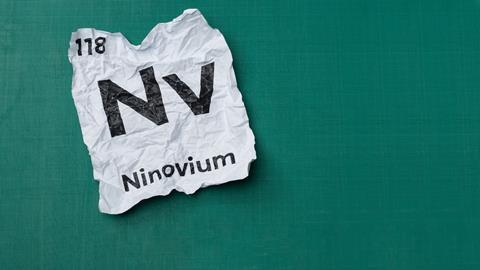


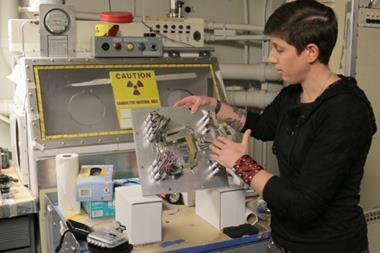









No comments yet